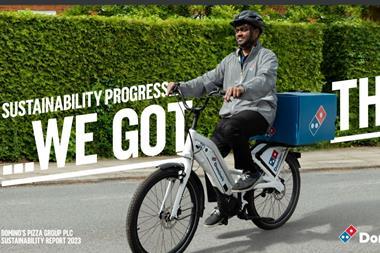The pot is £1.2bn - but can crèches and gyms save the high street?
Doom-laden figures from the BRC and KPMG this week suggest the high street has suffered its worst Christmas since 2008.
With HMV becoming the latest in a long line of retailers plunged into crisis, industry leaders appealed for urgent government intervention before it is too late.
But can a £675m government fund for local councils to rejuvenate high streets, opened for bidding off the back of a new report by retail veteran Sir John Timpson, provide the answers retailers are looking for? And will it succeed where previous initiatives such as the Portas Review failed?
Timpson, best known for his key cutting and shoe repair empire, was recruited by local government minister Jake Berry last summer to lead the High Streets Expert Panel, a team of retail gurus whose preliminary report before the Budget convinced ministers to set up the fund. It also won backing for a new High Streets Taskforce, otherwise known as the ’Timpson Institute’.
While the very phrase ‘taskforce’ elicited groans from cynics fed up with numerous previous guises, both government and independent, the cash up for grabs dwarfs that of previous initiatives like the Portas pilots.
Successful towns (the first of which are due to be announced later this year) will bid for up to £25m, with an expectation of matched funding from local or private sector funds, taking the total investment in high streets to a possible £1.2bn.
Opinion: It’s Groundhog Day for UK high streets with yet another review
The sort of projects envisaged include leisure centres, libraries, childcare centres and mini-gyms, alongside other experiential attractions, which will seek to ramp up footfall in centres and stop them turning into ghost towns.
But that could lead to more retail closures, not less, with with Sir John suggesting the UK has twice as many shops as it needs.
Meanwhile, the Local Government Association (LGA), the Institute of Place Management and PwC are battling it out for a separate £10m contract to run the new taskforce.
Its aim is to help support local leaders in finding unique solutions for communities, by arming them with data and links to other communities that have successfully rejuvenated centres.
Timpson’s final report, published in December, includes other ideas - some predictable, some quirky - ranging from a review of town centre parking charges to a ‘national perfect day’ when towns should strive to be as tidy and presentable as possible.
So far at least the report has received positive backing from business leaders, despite bitter recent memories of previous high street rescue efforts.
These include the Future High Streets Forum, set up by ministers in 2013, whose main achievement was to hold a national competition to find the best town centre, but which has not met since last summer despite a raft of companies going to the wall.
Before that came the Portas Pilots, set up following self-styled ‘Queen of Shops’ Mary Portas’ 2011 review, commissioned by David Cameron, which saw £2.3m of taxpayers’ cash frittered away in dozens of towns across the country, as well as a lucrative accompanying TV series on Channel 4 for Portas.
Timpson says this time it’s different.
He admits facing cynicism about his vision of “upside down government” because of the bitter memories of what went on before.
“We’re not trying to turn back the clock,” he tells The Grocer.
“But I’m convinced my report will make a difference as long as we get involvement from inspirational leaders in local areas.
“I think people forget the Portas Review was seven years ago. At the time I don’t think we recognised the way things were changing on the high street were quite as fundamental as they are.
“I’m confident retailers will return to the high street but we probably don’t even know at this stage what the businesses will be. We simply don’t know what they will be in 20 years’ time.”
Yet Sir John admits he has fears about how the £675m will be spent.
“My biggest worry is that you spend too much on bricks and mortar,” he says. “That’s not what we need it for.”
Opinion: The worst Christmas for 10 years? Not for the major mults
He says he has no intention of staying on as a longer-term retail tsar. “At my age the last thing I want to do is to go to lots of hollow meetings.”
But he is quick to defend the government from accusations of passing the buck for high street woes to local politicians.
“It’s missing the point. It’s not passing the buck, they are trusting local communities to come up with solutions. That’s being realistic. “It’s an act of facilitating.
“The biggest victory is the government has recognised it’s their job to make sure these communities are connected.”
Berry stresses the government’s financial support under the initiative is much bigger than anything that went before.
“Under Portas the maximum towns were getting was £100,000 whereas we’re planning to fund towns with up to £25m, which will be matched from other sources making up to £50m for communities. This is a step change from what went on before.”
He claims that since the time of the Portas Review there is now a much greater understanding of how the shift to online has transformed high streets, meaning the investment will be about rejuvenating centres as a whole, with retail as a part, rather than simply trying to turn the clock back on boarded up shops.
“There’s been a huge change in the way people shop, with 20% of purchases being made online. That was less than 5% when Mary Portas started her review.
Opinion: Why Gen Z could be the unexpected saviours of the high street
“That’s why this fund is about finding the best uses for spaces in town centres, with retail as a key part in that.”
“We can see differences to previous reports,” says Tom Ironside director of business and regulation at the BRC.
“For a start there a meaningful amounts of money, £675m, which dovetails with what we’ve been saying about the need to support local areas. It also reflects what we have been saying about the need for town centres to adapt and find new uses for space.”
Yet Ironside insists that the report still risks tinkering around the edges if the government ignores the need for fundamental reform of business rates.
“There are lots of good ideas but it doesn’t not get away from the fact that retailers are facing huge pressures from a fundamentally unfair tax system.”
Berry argues the real problem facing retailers is not rates but lack of footfall and sales.
Can this be solved by crèches, mini-gyms and town centres sprucing themselves up to look perfect, even for one day a year? As long as there is no accompanying Channel 4 TV series, many retailers may think it’s got to be worth a go.















No comments yet